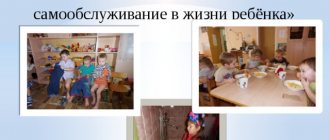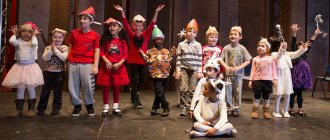Petrushka Theater
Special requirements are imposed on the Petrushka Theater, the components of which are:
- scenario;
- decoration;
- musical arrangement;
- artistic word;
- doll driving technique.
The script of the Parsley Theater stipulates that even a familiar work for children should contain something new: you can add characters and their actions, monologues, that is, weave, preferably, positive actions into the plot.
You should definitely avoid the author’s words, give them to different characters, or introduce a narrator character: Petrushka, the storyteller, the grandmother...
Fill the content of the script with such small folklore genres as proverbs, sayings, riddles, counting rhymes. It’s good when, for example, the riddles are solved by child spectators, who get the impression that they are directly participating in the performance.
It is better when the performance ends with the performance of a song about friendship, especially when the children sing along with the performing dolls, that is, the song should be familiar to the children.
Theater at the preschool educational institution. (Goal, task, result. Middle group)
THEATER "FAIRY TALE" In our kindergarten, in the "middle group" three fairy tales were staged in a playful way. (Turnip, Masha and three bears, a cockerel and a fox). Preliminary work was provided: Reading fairy tales, looking at pictures, discussing the characters, their habits, character, voice. The children chose the characters they liked, tried on masks, transformed into heroes and tried to put on a voice. Under the mask of a hero, even timid guys relaxed. The little actors gave wonderful performances. Everything was BRIGHT and FUN! Theater works wonders.
THEATER at the preschool educational institution. Target. Task. Result .
GBOU school No. 2055 preschool educational institution at the address: 2nd Krasnogvardeisky proezd, 4B
Introduction.
Today, teachers are faced with the task of improving traditional methods of preschool education of children and finding new approaches to organizing the educational process. The formation of communicative competence in future schoolchildren, their preparation for training within the framework of the Federal State Educational Standard of general education is one of the tasks of the educational institution. The main direction in the formation and development of children's communicative competence is theatrical and play activities in kindergarten. It is precisely this that allows a child to develop expressive speech, increase the level of his intellectual culture, raise an aesthetically developed personality, instill a love for his native culture, help everyone feel self-confidence, develop emotional responsiveness in a child, and at the same time has a pronounced healing character. Scientific research and pedagogical practice prove that the development of creative abilities begins in preschool age. At this age, children are extremely inquisitive, they have a great desire to learn about the world around them. The thinking of preschoolers is more free than the thinking of older children. It's more independent. And this quality needs to be developed. Theatrical activities make it possible to develop the experience of social behavior skills because every literary work for preschool children always has a moral orientation (friendship, kindness, honesty, courage). Thanks to theatricalization, the child not only learns about the world, but also expresses his own attitude towards good and evil, and becomes familiar with folklore and national culture. Therefore, the task of introducing children to theatrical activities becomes relevant for teachers of preschool institutions. Goal and tasks
The goal of pedagogical activity is to develop the creative abilities of preschool children through theatrical activities.
Objectives:
• develop a sustainable interest in theatrical and gaming activities;
• develop imagination, fantasy, attention, independent thinking; • improve gaming skills and creative independence through theatrical games that develop the creative abilities of preschoolers; • enrich and activate the vocabulary; • develop dialogic and monologue speech; • cultivate humane feelings in children. Methods and techniques for organizing theatrical activities Principles for conducting theatrical activities:
-
visibility in teaching
- is carried out on the perception of visual material (illustrations, video materials, excursions to the theater, musical fragments, theatrical performances by teachers of a children's institution);
- accessibility
- children's theatrical activities are designed taking into account age characteristics, built on the principle of didactics (from simple to complex);
— problematic
– aimed at finding solutions to problem situations;
— the developmental and educational nature of training is aimed at broadening one’s horizons, at developing patriotic feelings and cognitive processes. Working methods for organizing games - dramatizations: • the method of modeling situations
- involves creating model plots, model situations, sketches together with children;
• method of creative conversation
- involves introducing children to an artistic image through a special formulation of a question, dialogue tactics;
• method of associations
- makes it possible to awaken the child’s imagination and thinking through associative comparisons and then, based on the emerging associations, create new images in the mind.
The general methods of guiding the game - dramatization are direct (the teacher shows the methods of action) and indirect (the teacher encourages the child to act independently) techniques. Rules of dramatization: Rule of individuality.
Dramatization is not just a retelling of a fairy tale; it does not have strictly defined roles with pre-learned text.
Children worry about their hero, act on his behalf, bringing their own personality to the character. That is why the hero played by one child will be completely different from the hero played by another child. And the same child, playing a second time, can be completely different. Rule of all participation.
All children participate in dramatization.
If there are not enough roles to portray people and animals, then active participants in the performance can be trees, bushes, the wind, a hut, etc., which can help the heroes of the fairy tale, can interfere, or can convey and enhance the mood of the main characters. Rule of freedom of choice.
Each fairy tale is played out repeatedly.
It is repeated (but it will be a different fairy tale each time - see the rule of individuality) until each child has played all the roles he wants. Rule of helping questions.
To make it easier to play a particular role, after getting acquainted with the fairy tale and before playing it, each role is discussed and “spoken out” with the children.
Questions to children help with this: what do you want to do? What's stopping you from doing this? What will help you do this? How does your character feel? What is he like? What does he dream about? What is he trying to say? Feedback rule.
After playing the fairy tale, there is a discussion about it: What feelings did you experience during the performance?
Whose behavior, whose actions did you like? Why? Who helped you the most in the game? Who do you want to play now? Why? The rule of a wise leader.
Compliance and support by the teacher with all the listed rules of dramatization, an individual approach to each child.
Types of dramatization:
• games-imitation of images of animals, people, literary characters;
• role-playing dialogues based on text; • staging of works; • staging performances based on one or more works; • improvisation games with the acting out of a plot (or several plots) without prior preparation. Methods of work: • method of modeling situations
- involves creating model plots, model situations, sketches together with children;
• method of creative conversation
- involves introducing children to an artistic image through a special formulation of a question, dialogue tactics;
• method of associations
- makes it possible to awaken the child’s imagination and thinking through associative comparisons and then, based on the emerging associations, create new images in the mind.
The general methods of guiding the game
- dramatization are direct (the teacher shows the methods of action) and indirect (the teacher encourages the child to act independently) techniques.
CONCLUSION:
The following can be mentioned as the results of the work on organizing theatrical activities for children in preschool educational institutions: children become more emotional, more mobile; learn to understand art and express their impressions openly and honestly. A child who knows how to create an image on stage, transform and express his emotions becomes an emotional, open, cultural and creative person.
THANK YOU FOR YOUR ATTENTION!
Requirements for the decoration of the performance
The decoration should create a positive emotional state in children, facilitate understanding of the content of the performance, and complement it. The decoration should be bright, aesthetic, hygienic, conditionally proportional to each other (for example, a tree and a bush, a table and a chair), as well as in relation to the dolls (a doll and a bed, or a doll and a house, a tree).
There should be no unnecessary scenery that is not involved in the performance: there is a sun in the sky, let one of the characters pay attention to it, “How warm it is today, how brightly the sun is shining...”, if there are mushrooms on the stage, one of the characters needs to characters collected them...
Musical accompaniment of a theatrical performance
Of particular importance in the performance is its musical design, which appeals to aesthetic feelings and tunes in to the emotional perception of the performance. Music should begin the performance, complement the characters and their actions, generally lead the plot of the play, and evoke positive emotions in children.
The voiceover of the script text is of great importance, i.e. monologues embedded in the language of dolls. You need to use your voice to reveal each image as clearly as possible, and also do it in such a way that the children do not recognize the voice of their teacher, who is currently working behind a screen, because this will distract the children from the plot of the play, since the preschooler’s attention is unstable.
We must remember that behind the screen the voice changes and becomes deaf, so the text should be pronounced much louder and clearer than in everyday life. The text of the script must be known by heart, because driving the puppets and their language require some effort to combine them during the performance.
Driving a puppet on a screen requires careful preparation and testing of knowledge so that the faces “come to life” on stage during the performance. As in decoration, certain requirements for dolls should be adhered to: aesthetic, hygienic, pedagogical.
If the first two requirements are clear, then we should focus on the pedagogical requirements. This is especially true for negative characters. They should not be scary, so that child spectators do not get scared of them; the dubbing of their monologues should also not be painted over with a “scary” voice.



